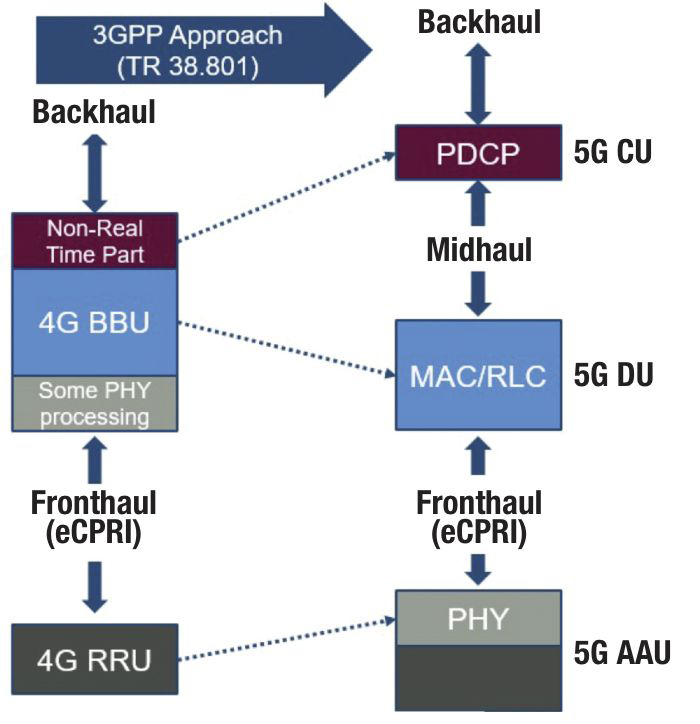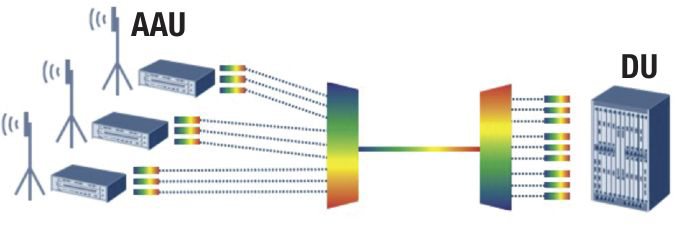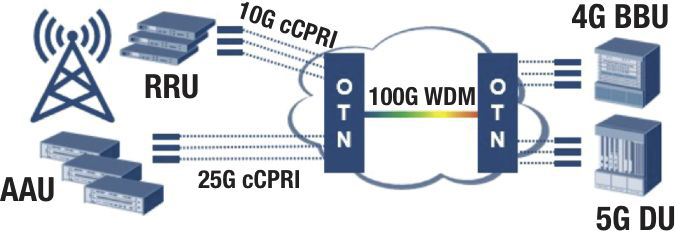5G Needs WDM …but will technicians cope with the technology?
By Mike Venter and Monica Hue
The 5G promise
4G LTE mobile networks have served us well for over a decade, but current user expectations and new applications demand change. New 5G networks should be at least 10 times faster than 4G LTE, promising to change the way people live, work, and communicate in the future — a rich eco-system of wireless applications including enhanced mobile broadband (eMBB), massive machine type communication (mMTC), and ultra-reliable low latency communications (uRLLC) are the cornerstones of this new transformative technology.
Each 5G application has very different bandwidth, latency, and clock precision requirements, mandating changes in the radio access network (RAN) architecture (Figure 1). 4G currently uses a two-level baseband unit (BBU) and remote radio unit (RRU) structure, however, 5G will disaggregate the traditional BBU, resulting in a three-level architecture comprising a centralized unit (CU), a distributed unit (DU), and an active antenna unit (AAU). The AAU will consolidate radio and antenna functions at the top of the tower or pole.

Figure 1. 5G RAN evolution
The underlying transport network will also evolve into three segments: Fronthaul is the part between an AAU and DU, midhaul between the DU and CU, and backhaul connects the CU to the core network (EPC/5GC). Fronthaul has the toughest performance requirements as it carries the lower layer split traffic including the in-phase and quadrature (IQ) frequency components — latency in particular is far more stringent than in the midhaul and backhaul network.
Fiber infrastructure will unlock 5G’s true potential
For eMBB, mMTC, and uRLLC applications to prosper, more optical fiber is needed to achieve the coverage, bandwidth, latency, and reliability objectives of each — ideally a fiber infrastructure is recommended all the way to the antenna. As such, fronthaul connections are leveraging fiber and associated technologies to bring the necessary capacity to the street, businesses, and homes.
Cell densification is also impacted by the frequency spectrum employed, with millimeter wave frequencies being the most demanding in terms of fiber infrastructure needed. A variety of fiber fronthaul technologies can be used in the C-RAN architecture, each having its advantages and disadvantages.
Dark fiber employing grey optics between the BBU and RRU/AAU offers the lowest latency and simplest deployment but consumes too many fibers — this option will be reserved for cell sites with abundant fiber resources only.
WDM maximizes fiber resources
Wavelength division multiplexing (WDM) technology mostly reserved for backhaul applications, is quickly becoming the preferred technology to unlock the bandwidth potential and maximize fiber resources in 5G fronthaul. Multiple wavelengths are multiplexed and transmitted over a single fiber, leading to greater efficiencies and cost savings. Depending on capacity requirements, coarse WDM (CWDM) or dense WDM (DWDM) options can be implemented.
Passive WDM systems (Figure 2) use only colored transceivers installed directly on network devices to connect multiple AAUs to a DU. Multiplexers (MUX) and demultiplexers (DeMUX) provide passive wavelength filtering at each link termination point. Solutions utilize either fixed or tunable optics and operate over a pair of fibers or a single fiber with bi-directional transmission.

Figure 2. Passive WDM connection
Active WDM systems (Figure 3) usually contain a transponder function and optical transport network (OTN) with overhead functions to guarantee service quality. OTN elements and mapping, however, introduce unwanted latency in the fronthaul network and are thus preferred in the backhaul network where ring and mesh architectures provide additional redundancy.

Figure 3. Active WDM connection
Will fronthaul cope with DWDM?
Unlike backhaul networks that often employ amplifiers and other active devices, 5G fronthaul DWDM networks are designed to be less complex. Operators have aggressive deadlines, so deployment must be quick and efficient, with a strong emphasis on “plug and play” with little provisioning. But despite these objectives, wavelength continuity, insertion loss, and spectral attributes still need be verified to ensure fronthaul links function correctly.
Fronthaul technicians are mostly unfamiliar with DWDM, some even intimidated by the technology, so testing must be simple and straightforward. A new generation of intuitive and cost effective DWDM test equipment has thus emerged to streamline the testing aspects. Specialized power meters, laser sources, and optical channel checkers enable loss and spectral measurements during new network construction, while DWDM optical time domain reflectometers (OTDR) are suited to validate wavelength continuity, plus identify, and troubleshoot any link impairments or abnormal MUX losses when the network is in service.
 Mike Venter,
Mike Venter,
CEO, OptixSource LLC
Mike Venter is CEO of OptixSource LLC, a fiber consulting company. Previously, he worked at VeEX since its inception in 2006 where he held various senior management positions, most recently as Vice President Product Development, Fiber Optics.
 Monica Hua,
Monica Hua,
Product Marketing Engineer, VeEX Inc.
Monica Hua is a Product Marketing Engineer for OTDR and OSA products at VeEX Inc. Monica received her Bachelor’s degree from the University of California, Santa Cruz in Cognitive Science with an emphasis in Human-Computer Interaction and Artificial Intelligence.


